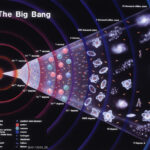In Switzerland, a dedicated 18-year-old high school student, pursuing the International Baccalaureate (IB) diploma, devotes himself to disseminating knowledge. Whether it’s through authoring articles at ‘The Secrets Of The Universe’, tutoring peers, or fostering communities with shared academic interests, his commitment to spreading enlightenment is unwavering.
The Accepted Model of Black Holes
Presently, the widely endorsed theory of black holes paints a picture of these cosmic phenomena as fascinating and complex. They are envisaged as regions in spacetime, an intricate fabric woven from three spatial dimensions and time itself, enveloping a singularity. This core, the singularity, stands as a point of infinite density, a concept challenging the very foundations of physics. It represents a location where the conventional laws of space and time cease to function, propelling us into the realms of the unknown.
At the heart of a black hole, within this boundary known as the event horizon, the rules of the universe alter drastically. Here, the gravitational pull is so immense that nothing, not even light, the fastest entity in our known universe, can escape its clutches. This inescapability renders black holes invisible and mysterious, observable only by the effects they exert on surrounding matter and light. The event horizon acts as a point of no return; beyond this boundary, all matter and radiation are inevitably drawn into the enigmatic depths of the black hole.
This contemporary understanding of black holes challenges and extends our comprehension of physics, compelling us to consider the extreme conditions under which the conventional rules of the universe might unravel. It’s a testament to human curiosity and the unending quest to understand the cosmos that we continue to delve deeper into these cosmic enigmas, seeking to unravel their secrets and the profound implications they hold for our understanding of the universe.
The Event Horizon Telescope’s Achievement
Today, black holes are not just intriguing cosmic phenomena but also serve as crucial subjects for testing theories like quantum gravity. These enigmatic entities allow scientists to observe the behavior of physical laws under extreme conditions. It was only recently that black holes, long relegated to theoretical speculation, were visually captured for the first time by the Event Horizon Telescope in 2019.
The Evolution of Black Hole Theory
Pioneering Concepts
The exploration of black holes, a journey marred with curiosity and perplexity, embarked in 1784 when John Michell first introduced the concept of ‘dark stars’. These celestial entities, he hypothesized, possessed such an overwhelming gravitational force that not even light, the fastest known entity in the universe, could break free from their grasp. This idea marked the inception of what we now understand as black holes. In a parallel development, the French mathematician Pierre-Simon Laplace, unaware of Michell’s work, independently deduced similar conclusions. He ventured into uncharted territories of astrophysics, attempting to calculate the size of these mysterious bodies.
However, the evolution of scientific understanding about the nature of light brought about a paradigm shift. When light was redefined as a wave rather than just a particle, Michell and Laplace’s theories were cast into the shadows, their relevance questioned and their potential implications overlooked for more than a century. This period saw a significant lull in the study of these cosmic phenomena, as the scientific community grappled with new discoveries and theories that reshaped their understanding of the universe.
It was not until the advent of new theories and technological advancements that the concept of black holes regained attention, prompting a resurgence in the study of these enigmatic objects. This revival marked a new era in astrophysics, as the ideas once dismissed began to form the cornerstone of our modern understanding of these fascinating cosmic entities.
Einstein and Schwarzschild’s Contributions
Albert Einstein’s 1915 theory of General Relativity reshaped the understanding of massive cosmic bodies. It was Karl Schwarzschild, however, who derived a crucial solution from Einstein’s equations, determining a critical radius for gravitational collapse, now known as the Schwarzschild radius.
Chandrasekhar’s Insight
In 1930, the field of astrophysics witnessed a significant advancement with the groundbreaking work of Subrahmanyan Chandrasekhar, an astrophysicist who brought a new dimension to our understanding of black holes. Chandrasekhar, challenging the prevailing beliefs about the nature of white dwarfs, embarked on a journey that would reshape our comprehension of stellar evolution. His most notable contribution was the introduction of the Chandrasekhar limit, a concept that has become a cornerstone in the study of stellar dynamics.
The Chandrasekhar limit represents a critical mass threshold for white dwarfs, the final evolutionary states of stars not massive enough to become neutron stars or black holes. Chandrasekhar posited that if the mass of a white dwarf exceeded approximately 1.4 times the mass of the sun, it would not be able to support itself against gravitational collapse. This insight implied that beyond this limit, white dwarfs would be destined to undergo a dramatic transformation, leading to their collapse into black holes or neutron stars.
Chandrasekhar’s theory was initially met with skepticism, as it challenged the then-accepted norms of astrophysics. However, his persistence and rigorous mathematical support for his theory eventually led to its acceptance, marking a pivotal moment in astrophysical research. The Chandrasekhar limit not only deepened our understanding of how stars end their life cycles but also provided crucial insights into the conditions necessary for the formation of black holes, thereby enriching the tapestry of knowledge in the field of stellar astrophysics.
WWII Era and Beyond
During WWII, Robert Oppenheimer proposed that massive stellar bodies could collapse under their gravity, but his theories remained largely unacknowledged. It wasn’t until 1963 that John Wheeler popularized the term ‘black holes,’ and Roy Kerr proposed a model for rotating black holes.
Hawking’s Revelation
Stephen Hawking, in 1974, posited that black holes could emit radiation, a concept that contradicted the idea that nothing escapes a black hole. This phenomenon, known as Hawking radiation, suggested that black holes could eventually evaporate.
The Pinnacle of Black Hole Research
The year 2015 marked a watershed moment in astrophysics with the Laser Interferometer Gravitational-Wave Observatory (LIGO)’s historic detection of gravitational waves, a phenomenon first predicted by Albert Einstein in his Theory of Relativity. This monumental discovery emanated from the merger of two black holes, providing not only a resounding validation of Einstein’s theory but also offering concrete, observable evidence of the existence of black holes. This groundbreaking event opened a new window into the universe, allowing scientists to observe and study cosmic phenomena in a way that was previously impossible.
LIGO’s achievement was complemented by another significant breakthrough in 2019, when the Event Horizon Telescope (EHT) captured the first-ever image of a black hole. This image, a visual confirmation of a black hole’s event horizon, marked a historic moment in our quest to understand these enigmatic cosmic entities. It offered a glimpse into the extreme realms of spacetime, where gravitational forces are so intense that they warp and curve the fabric of the cosmos.
These developments represent more than just scientific achievements; they signify a leap in our ability to probe the mysteries of the universe. The detection of gravitational waves and the imaging of a black hole’s event horizon are not just validations of theoretical physics but are milestones that underscore our growing understanding of the universe’s most mysterious and powerful phenomena. They highlight the incredible progress we have made in our cosmic exploration and the endless possibilities that await in our ongoing quest to unravel the secrets of the cosmos.
Ongoing Debates and Alternative Models
Despite these advancements, debates continue in the astrophysical community. While some scientists question the traditional model of black holes, others propose alternative theories like gravastars, naked singularities, and MECOs (Magnetospheric Eternally Collapsing Objects). MECOs, differing from black holes in their ability to generate magnetic fields and not collapsing into a singularity, offer a compelling alternative theory.
For further exploration of MECOs and their distinction from traditional black hole models, interested readers can delve into recently published resources, including a comprehensive blog by Prof. Mirta, detailing these differences and linking to relevant peer-reviewed studies. Prof. Mitra’s insights on the subject are also accessible through his TEDx talk.
Conclusion: Reflecting on the Mysteries of the Cosmos
As we stand at the cusp of new astronomical discoveries and theories, the study of black holes continues to captivate and challenge our understanding of the universe. The journey from early speculations about ‘dark stars’ to the groundbreaking image capture of a black hole by the Event Horizon Telescope represents not just scientific progress, but a testament to human curiosity and perseverance. Each development, from Einstein’s revelations to Hawking’s paradoxical findings, underscores a deeper narrative of our relentless pursuit of knowledge.
The dichotomy in the scientific community, with some advocating for traditional black hole models and others proposing alternatives like MECOs, reflects the vibrant and dynamic nature of scientific inquiry. These debates are not mere academic exercises but are crucial in refining our understanding of the universe. They push the boundaries of known physics and challenge us to rethink our assumptions.
In the face of these cosmic giants, we are reminded of both the vastness of the universe and the intricacy of its underlying principles. As technology advances and our observational tools become more sophisticated, we edge closer to unraveling the mysteries that black holes present. The continued exploration of these enigmatic entities is not just a journey through space but through the limits of human intellect and imagination.
As this field evolves, it beckons a new generation of thinkers and explorers, inspired by the unknown, to venture into the depths of space and thought. The study of black holes, therefore, is more than a scientific endeavor; it is a journey that continues to inspire awe and wonder about our place in the vast cosmos.





